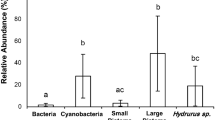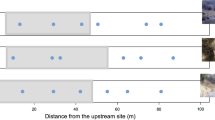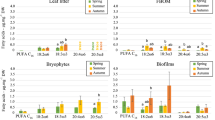Abstract
We investigated the diets of stream detritivores in a coniferous plantation and a deciduous-coniferous mixed forest using stable isotope (δ13C and δ15N) mixing models. In summer, collector-gatherers (Ephemera japonica, McLachlan, and Paralichas sp.) and a shredder (Lepidostoma crassicorne, Ulmer) utilized coniferous needle litter but not broad-leaved deciduous litter as their food resource because coniferous litter was persistent and remained on the streambed in both the forests even in summer. In early spring, L. crassicorne in the mixed forest utilized both coniferous needle litter and broad-leaved deciduous litter because both were abundant and available. However, coniferous needle litter was the only dominant food source available for the shredder species in the plantation where deciduous trees were less abundant. E. japonica and a collector-filterer (Hydropsyche sp.) in the forest possibly utilized fine materials derived from coniferous needle litter but not those derived from broad-leaved deciduous litter as their food resource. Although previous studies have indicated that coniferous needle litter is less nutritious than broad-leaved deciduous litter, persistence of the coniferous needle litter provides a stable basal food resource for shredders, collector-gatherers, and collector-filterers in forested streams that receive litter inputs from neighboring conifers.



Similar content being viewed by others
References
Abelho, M. & M. A. S. Graça, 1998. Litter in a first-order stream of a temperate deciduous forest (Margaraça Forest, central Portugal). Hydrobiologia 386: 147–152.
Allan, J. D. & M. M. Castillo, 2007. Stream Ecology: Structure and Function of Running Waters, 2nd ed. Springer, Dordrecht.
Benke, A. C. & J. B. Wallace, 1980. Trophic basis of production among net-spinning caddisflies in a southern Appalachian stream. Ecology 61: 108–118.
Biggs, B. J. F., 1996. Patterns in benthic algae of streams. In Stevenson, R. J., M. L. Bothwell & R. L. Lowe (eds), Algal Ecology: Freshwater Benthic Ecosystems. Academic Press, California: 31–56.
Biggs, B. J. F. & M. E. Close, 1989. Periphyton biomass dynamics in gravel bed rivers: the relative effects of flows and nutrients. Freshwater Biology 22: 209–231.
Bisson, P. A. & D. R. Montogomery, 2006. Valley segments, stream reaches, and channel units. In Hauer, F. R. & G. A. Lamberti (eds), Methods in Stream Ecology, 2nd ed. Academic Press, London: 23–49.
Cross, W. F., J. P. Benstead, P. C. Frost & S. A. Thomas, 2005. Ecological stoichiometry in freshwater benthic systems: recent progress and perspectives. Freshwater Biology 50: 1895–1912.
Cummins, K. W. & M. J. Klug, 1979. Feeding ecology of stream invertebrates. Annual Review of Ecology and Systematics 10: 147–172.
Cummins, K. W., M. A. Wilzbach, D. M. Gates, J. B. Perry & W. B. Taliaferro, 1989. Shredders and riparian vegetation: leaf litter that falls into streams influences communities of stream invertebrates. BioScience 39: 24–30.
Dunn, R. D., 1954. The feeding habits of some of the fishes and some members of the bottom fauna of Llyn Tegid (Bala lake), Merionethshire. Journal of Animal Ecology 23: 224–233.
Frazer, G. W., C. D. Canham & K. P. Lertzman, 1999. Gap Light Analyzer (GLA) Imaging Software to Extract Canopy Structure and Gap Light Transmittion Indices from True Colour Fisheye Photographs: User Manual and Program Documentation. Version 2.0. Simon Frazer University, Burnaby.
Friberg, N., 1997. Benthic invertebrate communities in six Danish forest streams: impact of forest type on structure and function. Ecography 20: 19–28.
Friberg, N. & D. Jacobsen, 1994. Feeding plasticity of two detritivore-shredders. Freshwater Biology 32: 133–142.
Hisabae, M., S. Sone & M. Inoue, 2010. Breakdown and macroinvertebrate colonization of needle and leaf litter in conifer plantation streams in Shikoku, southwestern Japan. Journal of Forest Research 16: 106–115.
Kanasashi, T. & S. Hattori, 2011. Seasonal variation in leaf-litter input and leaf dispersal distances to streams: the effect of converting broadleaf riparian zones to conifer plantations in central Japan. Hydrobiologia 661: 145–161.
Kawai, T. & K. Tanida, 2005. Aquatic Insects of Japan: Manual with Keys and Illustrations. Tokai University Press, Kanagawa.
Merritt, R. W., K. W. Cummins & M. B. Berg, 2008. An Introduction to the Aquatic Insects of North America. Kendall/Hunt Publishing Company, Iowa.
Moore, J. W. & B. X. Semmens, 2008. Incorporating uncertainty and prior information into stable isotope mixing models. Ecology Letters 11: 470–480.
Ota, I., 2007. A forest owners’ cooperative in Japan: obtaining benefits of certification for small-scale forests. Unasylva 58: 64–66.
Polyakova, O. & N. Billor, 2007. Impact of deciduous tree species on litterfall quality, decomposition rates and nutrient circulation in pine stands. Forest Ecology and Management 253: 11–18.
Porra, R. J., W. A. Thompson & P. E. Kriedemann, 1989. Determination of accurate extinction coefficients and simultaneous equations for assaying chlorophylls a and b extracted with four different solvents; verification of the concentration of chlorophyll standards by atomic absorption spectroscopy. Biochemica et Biophysica Acta 975: 384–394.
Richardson, J. S. & R. J. Danehy, 2007. A synthesis of the ecology of headwater streams and their riparian zones in temperate forest. Forest Science 53: 131–147.
Richardson, J. S., C. R. Shaughnessy & P. G. Harrison, 2004. Litter breakdown and invertebrate association with three types of leaves in a temperate rainforest stream. Archiv für Hydrobiologie 159: 309–325.
Sakai, M., Y. Natuhara, K. Fukushima, A. Imanishi, K. Imai & M. Kato, 2013a. Ecological functions of persistent Japanese cedar litter in structuring stream macroinvertebrate assemblages. Journal of Forest Research 18: 190–199.
Sakai, M., Y. Natuhara, K. Fukushima, R. Naito, H. Miyashita, M. Kato & T. Gomi, 2013b. Responses of macroinvertebrate communities to 4 years of deer exclusion in first- and second-order streams. Freshwater Science 32: 563–575.
Semmens, B. X. & J. W. Moore, 2008. MixSIR: A Bayesian Stable Isotope Mixing Model, Version 1.0. http://www.ecologybox.org.
Vander Zanden, M. J. & J. B. Rasmussen, 2001. Variation in δ15N and δ13C trophic fractionation: implications for aquatic food web studies. Limnology and Oceanography 46: 2061–2066.
Vannote, R. L., G. W. Mainshall, K. W. Cummins, J. R. Sedell & C. E. Cushing, 1980. The river continuum concept. Canadian Journal of Fisheries and Aquatic Sciences 37: 130–137.
Wallace, J. B., S. L. Eggert, J. L. Meyer & J. R. Webster, 1997. Multiple trophic levels of a forest stream linked to terrestrial litter inputs. Science 277: 102–104.
Webster, J. R. & E. F. Benfield, 1986. Vascular plant breakdown in freshwater ecosystems. Annual Review of Ecology and Systematics 17: 567–594.
Acknowledgments
We thank the staff of the Ashiu Forest Research Station for assistance and maintenance of field access. A portion of this study was supported by JSPS KAKENHI Grant Numbers 10J00142 and 26660127, and the River Fund in charge of the Foundation of River and Watershed Environment Management, Japan.
Author information
Authors and Affiliations
Corresponding author
Additional information
Handling editor: Checo Colón-Gaud
Rights and permissions
About this article
Cite this article
Sakai, M., Fukushima, K., Naito, R.S. et al. Coniferous needle litter acts as a stable food resource for stream detritivores. Hydrobiologia 779, 161–171 (2016). https://doi.org/10.1007/s10750-016-2813-8
Received:
Revised:
Accepted:
Published:
Issue Date:
DOI: https://doi.org/10.1007/s10750-016-2813-8




